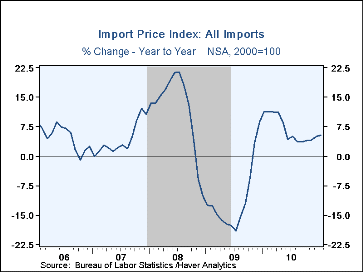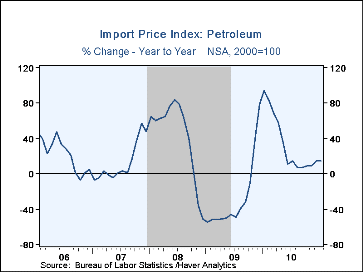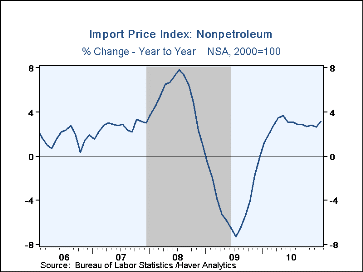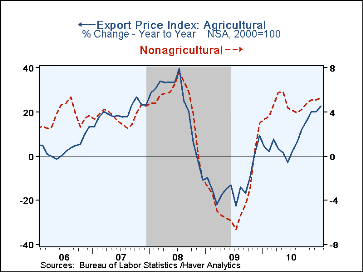 Global| Feb 15 2011
Global| Feb 15 2011U.S. Import Prices Firm
by:Tom Moeller
|in:Economy in Brief
Summary
U.S. import prices showed broad-based strength. During January, prices jumped another 1.5% after an upwardly revised 1.2% December increase, initially reported as 1.1%. The increase was stronger than Consensus expectations for a 0.8% [...]
U.S. import prices showed broad-based strength. During January, prices jumped another 1.5% after an upwardly revised 1.2% December increase, initially reported as 1.1%. The increase was stronger than Consensus expectations for a 0.8% rise. The gain was paced by a 3.4% increase in petroleum while nonpetroleum prices rose 1.1%, the most for any month since June 2008.
Earlier strength in petroleum prices continued this month. Yesterday, Brent crude oil prices jumped to $102.33 per barrel compared to $97.66 in January. For January, non-oil import prices rose 1.1% and 3.2% y/y. (The y/y change in non-oil import prices during the last ten years has had an 81% inverse correlation with the nominal trade-weighted exchange value of the US dollar vs. major currencies.)
In January, imported food & beverage prices again led the overall price gain with a 2.6% increase, up 14.8% y/y. Prices for nonoil industrial supplies rose 3.3% (10.5% y/y) paced by a 20.5% y/y increase in unfinished metals prices. Prices for non-auto consumer goods rose 0.3% but were unchanged during the last twelve months. Home entertainment equipment prices declined 10.2% y/y and furniture prices slipped 0.4%. Apparel prices rose 3.2% y/y. Imported auto prices rose 1.4% during the last twelve months while imported capital goods prices ticked 0.2% higher. Computer & peripherals prices fell 3.7% y/y but excluding computers, capital goods prices rose 1.8%.
Total export prices jumped another 1.2% last month and rose a strong 6.8 y/y. The gain reflected continued strength in agricultural exports, up 22.6% y/y. Non-agricultural goods prices rose a steady 0.9% last month and 5.3% y/y. Strength has been notable for industrial supplies (15.4% y/y) and nonauto consumer goods, up 2.7% y/y.
The import and export price series can be found in Haver's USECON database. Detailed figures are available in the USINT database.
| Import/Export Prices (NSA, %) | Jan | Dec | Nov | Jan Y/Y | 2010 | 2009 | 2008 |
|---|---|---|---|---|---|---|---|
| Imports - All Commodities | 1.5 | 1.2 | 1.6 | 5.3 | 6.8 | -11.5 | 11.5 |
| Petroleum | 3.4 | 4.3 | 5.0 | 14.3 | 28.2 | -35.9 | 37.7 |
| Nonpetroleum | 1.1 | 0.4 | 0.8 | 3.2 | 2.8 | -4.1 | 5.3 |
| Exports - All Commodities | 1.2 | 0.6 | 1.5 | 6.8 | 4.9 | -4.6 | 6.0 |
| Agricultural | 3.2 | 1.7 | 7.6 | 22.6 | 7.8 | -12.8 | 21.6 |
| Nonagricultural | 0.9 | 0.6 | 0.8 | 5.3 | 4.6 | -3.7 | 4.5 |
Tom Moeller
AuthorMore in Author Profile »Prior to joining Haver Analytics in 2000, Mr. Moeller worked as the Economist at Chancellor Capital Management from 1985 to 1999. There, he developed comprehensive economic forecasts and interpreted economic data for equity and fixed income portfolio managers. Also at Chancellor, Mr. Moeller worked as an equity analyst and was responsible for researching and rating companies in the economically sensitive automobile and housing industries for investment in Chancellor’s equity portfolio. Prior to joining Chancellor, Mr. Moeller was an Economist at Citibank from 1979 to 1984. He also analyzed pricing behavior in the metals industry for the Council on Wage and Price Stability in Washington, D.C. In 1999, Mr. Moeller received the award for most accurate forecast from the Forecasters' Club of New York. From 1990 to 1992 he was President of the New York Association for Business Economists. Mr. Moeller earned an M.B.A. in Finance from Fordham University, where he graduated in 1987. He holds a Bachelor of Arts in Economics from George Washington University.










